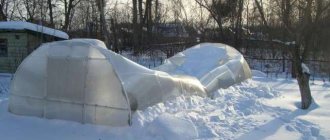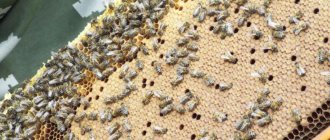Plants » Flowers
0
1150
Article rating
Kira Stoletova
The rose is quite capricious to its growing conditions. Long, frosty winters pose a particular danger. In the southern regions it can easily tolerate light frosts, but in northern latitudes it will have to make efforts to preserve its beauty until next spring. Let's look at how to cover roses for the winter in the Moscow region.
Covering roses for the winter in the Moscow region - rules and terms
Which roses need shelter for the winter?
Before you start covering, you need to decide what varieties and varieties your roses belong to. Some of them have high frost resistance and do not need additional protection in winter. For example, park, wrinkled roses do not require shelter for the winter; some varieties also have excellent winter hardiness: Scabrosa, Hansa and others. You can find out the frost resistance of your roses when purchasing seedlings at a nursery or in a reference encyclopedia.
Preparatory work before shelter
In order for rose bushes to winter well, it is necessary to carry out appropriate preparation. Roses are fed, hilled, pruned, and treated for diseases and pests. All these procedures are done in advance:
- Feeding. In autumn, roses need fertilizers with a high potassium content. It is this element that strengthens the shoots and roots of the plant, making it resistant to adverse environmental influences. For this purpose, ready-made industrial autumn fertilizers for roses are used. Instead, you can add ash to the root zone and water it. Ash powder contains all the components necessary for plants in the fall. You can independently make a mixture of 20 g of superphosphate, 10 g of potassium sulfate and 2 g of boric acid (per 10 liters of water). If the roses were planted this year in the spring, they do not need autumn feeding.
- Trimming. In the second half of September, rose stems are cleared of wilted leaves, which only evaporate moisture. If the leaves are left under cover, they may rot or become a source of fungal infection. The stems are pruned when the temperature drops to 0° C. For tall roses, the stems are cut to approximately 2/3 of their length. The cut is made 1 cm above the last bud. Deep pruning is especially necessary in the case of rejuvenating bushes. In low-growing varieties, shoots are shortened by 10-15 cm.
- Preventive treatment. Even if the roses have not been sick with anything this season, before covering they should be treated with a 2% solution of Bordeaux mixture or iron sulfate. Drugs can be used for the same purpose. For example, “Skor”, “Topaz”, “Fundazol”, “Hom”, “Ridomil Gold”. All products are used strictly according to the instructions. If any of the drugs was used in the spring, it should be replaced with another. Biological fungicides are not suitable for use in autumn, as they only work effectively at temperatures above 15° C.
- Hilling. After processing, the roses are hilled to a height of 30 cm. First, plant debris is collected under the bushes and the earth is dug up. This technique will promote good aeration in the lower part of the bush, which will serve as protection for roses from frost.
Unlike other crops, roses do not require moisture-recharging watering; with the onset of autumn, plants, on the contrary, begin to be watered less frequently. Excess moisture will stimulate the development of new shoots, and on the eve of wintering this is inappropriate.
In dry, warm weather, roses are watered every 7-10 days; starting from the second half of September, the soil should be moistened no more than once every 2 weeks. In rainy weather, decorative bushes, on the contrary, are protected from excess moisture by building a canopy over them or by draining water from the root zone using a small groove.
Now all that remains is to build a reliable shelter for the roses for the winter, so that the plants do not die, but will please you with luxurious flowering next season.
When to start covering roses?
Once you have decided on frost resistance and come to the conclusion that your roses still require shelter in the winter, you need to understand when to start work. Many types of roses tolerate light frosts well and withstand sub-zero temperatures. We advise you to start preparing and covering roses when the temperature outside is stable -5, -7 C. Do not worry about your seedlings, if there are temperature changes outside (from + to -), the seedlings need some hardening and preparation for frost - this is for them won't hurt.
Preparing for winter
During the warm season, roses bloom almost continuously, causing the plant to draw all the nutrients and minerals from the ground. Even with abundant fertilizing, the soil is depleted and needs to be additionally fertilized for the winter.
Flower growers begin such activities in early to mid-September, using special autumn preparations as fertilizers. They must consist of the right “autumn” components, because if you add summer fertilizer to the soil, vegetative processes will begin in the bush, and it will begin to produce green shoots without having time to prepare for frost. Based on this, it is better to completely abandon organic fertilizers.
Among the promising fertilizers for autumn are:
- potassium;
- calcium;
- phosphorus.
You can try to create a highly effective product with your own hands. To do this, you need to dilute any component in a bucket of water, and then pour it moderately on each bush. Experienced flower growers recommend sticking to a proportion of 15 g of fertilizer per 10 liters of water. But you can not waste time and buy a ready-made mixture at a florist store, and then treat the crop with it.
Advice!
Also in the autumn, ash is introduced under the root system of rose bushes, and water is poured on top. This component contains the components that the rose needs to prepare for the cold in autumn.
How to prepare seedlings?
Covering roses in the fall primarily implies proper preparation of the seedling. Since roses have lost a lot of strength and nutrients during flowering in the summer, they need to be fed. As we have already said in our other articles, in the fall seedlings are fed only with phosphorus-potassium fertilizers, which help the seedlings gain strength for the winter period and recover faster in the spring. Nitrogen fertilizers are strictly prohibited in the fall, as they are for the development and growth of plants, and our seedlings, which are preparing for the dormant period, do not need this.
You can read in detail how to prune roses in the fall before covering in our article. It is recommended to prune many types of roses, leaving 30-40 cm from the base of the shoots. This will make the sheltering process easier and increase survival and recovery in the spring.
The next stage of preparation is cleaning the leaves. For a long time, gardeners around the world argue: should they remove the leaves from the shoots or leave the roses with the remaining leaves? We recommend carefully plucking the leaves from the shoots, as they can be sources of various diseases. Also an important point when preparing roses for winter is cleaning the tree trunk from leaves and debris. All leaves and debris must be recycled, such as incinerated.
When preparing seedlings for winter, special attention should be paid to climbing roses. Covering climbing roses involves careful placement of the shoots. Already from mid-October, the shoots of climbing roses are carefully removed from the support and a weight is placed on them. This can be either a plank or any structure that will help the shoots lay down to the ground without damage. If you do not prepare the shoots in this way, they can be damaged when covering them, since by autumn they become weakened and brittle.
Autumn processing of roses
Since many varieties of roses are susceptible to various diseases and pests, in the fall it is recommended to treat the shoots and tree trunks with copper-containing preparations. This will help protect the seedlings from death in the spring. On our website you can find an article on preparations for autumn plant prevention, and it will help you decide how to treat roses before covering.
Sheltering roses for the winter: basic rules and principles
Climbing roses require a more careful and responsible covering process, as they have long shoots that can easily be damaged when they are laid to the ground.
Above we described how to safely prepare the branches, now let's talk about the shelter itself. The first method of shelter is more economical and simpler:
- the base of the tree trunk circle is covered with sand, earth or peat and covered with spruce branches
- the shoots are laid on top of the layer and the whole thing is once again covered with spruce branches or covering material
This structure is removed gradually in layers - the seedlings need to be ventilated before being completely released
Another way to cover climbing roses, but more complex:
- the shoots are twisted into a bundle and bent to the ground on a wire structure, so that the branches do not touch the ground - a frame is created above the laid branches and wrapped in covering material so that it covers all sides of the structure
- up to - 5C leave the sides of the structure slightly open and only at stable sub-zero temperatures securely cover the entire frame
Spraying and hilling bushes
Each climbing bush needs regular spraying with special preparations against pests. Rose is a very vulnerable crop, which is susceptible to all sorts of diseases and can become an attractive environment for the development of dangerous diseases.
To avoid infection, you should use high-quality antifungal and antiviral agents. Old antiquated methods in the form of tobacco solution are powerless here. It is better to give preference to the following options:
- inkstone;
- Bordeaux mixture.
Important!
When performing the procedure, it is important not to spare liquid and thoroughly rinse the stems, branches and even the soil composition.
The next stage of caring for rose bushes is hilling. After successfully pruning, fertilizing and spraying the plant, you can begin to hill it, loosening the soil at this time. This action will ensure effective air passage due to the absence of weeds, and will also protect the rose from the effects of cold weather.
Peat, humus or dry leaves are poured on top of the soil. It is important to make sure that it is really dry, because dangerous viruses, fungi and parasites can develop in a humid environment. It is better to carry out hilling in dry, windless weather. Any moisture will lead to irreversible consequences.
Advice!
If there is no desire to carry out short pruning, tall stems will have to be bent. You should be extremely careful at this stage, otherwise you may damage the shoots. To avoid this, they need to be laid on the ground and then bent in arcs.
Park, floribunda and ground cover roses: do they need to be covered?
Since park roses have high winter hardiness, many gardeners do not cover them. We recommend playing it safe and creating additional protection for the seedlings so that these charming roses will delight you with lush blooms in the summer. Floribunda and groundcover roses also need light cover, so we have combined them into one group. Winter shelter for roses for these species is simple: it is enough to hill up the seedlings with garden soil or, for example, peat and cover the top with spruce branches of coniferous branches.
Shelter of standard roses
If you are the happy owner of standard roses, it is very important to know how to protect seedlings from severe frosts. This process is not the easiest, but in return for proper preparation and shelter of seedlings for winter, standard roses will delight you with incredible flowering and a healthy, well-groomed appearance. Before sheltering for the winter, standard roses undergo sanitary pruning - dry and brittle branches are removed. After this, if the seedling is young, the trunk can be carefully bent to the ground, the base can be sprinkled with peat or soil and, like climbing roses, covered with spruce branches or covering material.
The second method of covering standard roses involves installing a wooden frame in the shape of a “wigwam”. After the seedlings are prepared for wintering, a structure is installed around it and wrapped with covering material. You can add sawdust or pine needles inside the shelter.
The third method is the most labor-intensive and requires great care. On one side of the trunk it is necessary to remove the soil and then, using a shovel, carefully pry up the lump with the rhizome on the other side and slowly lay the trunk on the ground, securing it with pins. After this, you need to cover both the crown and the root system with spruce branches or covering material.
Sheltering roses in the Moscow region is a responsible and demanding process, but if the seedlings are properly prepared for winter, they will delight you with abundant flowering all summer long.
How to properly cover roses with covering material photo
Various natural and synthetic materials are used as covering material to protect roses from winter frosts:
- Snow can rightfully be considered the best shelter, but for the Moscow region with frequent thaws it is impossible to rely on it alone. During warming periods, it will thaw and cake. This can lead to unpleasant consequences: damp shoots will freeze during subsequent frosts or break.
- You can put spruce branches under the bushes and cover the roses on top. The only problem is that it is not always available in the required quantities.
- Spruce sawdust is good for everyone, but during sudden thaws it becomes damp and then freezes into a solid lump.
- Dry oak or birch leaves. However, they should not only be collected on dry, sunny days, but also be free from pest larvae and pathogens.
- Synthetic materials – agrofibre, film materials.
The most reliable way to cover roses, especially in conditions of fluctuating temperatures, is air-dry. In this case, you can optimally use all the advantages of both natural and synthetic materials.
To organize an air-dry shelter, frames are installed above the bushes, which are covered with film material.
For frames, arcs from greenhouses or greenhouses or wooden panel structures are usually taken. The frames are covered with a film on top, the edges of which are pressed to the ground either with special pins, or simply sprinkled with soil.
Such frames are usually covered with snow, and in snowless, frosty winters they are covered with spruce branches. The main advantage of such shelters is the ability to ventilate them when the air temperature rises.











